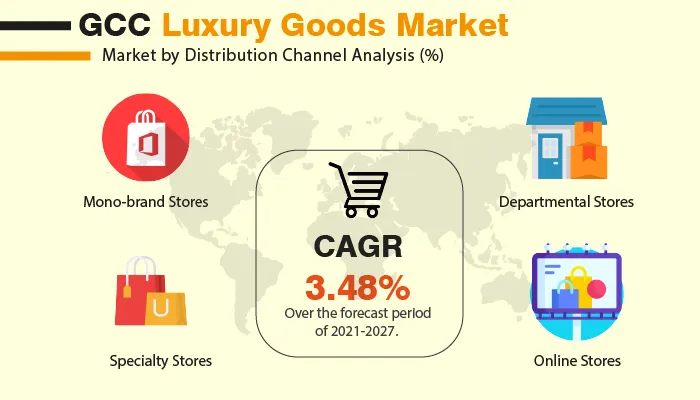GCC Luxury Goods Market (Type - Accessories, Apparel, Watch and Jewelry, Luxury Cosmetics, and Others; Gender - Female, and Male; Distribution Channel - Mono-brand Stores, Specialty Stores, Departmental Stores, Online Stores, and Others): Industry Analysis, Trends, Size, Share and Forecasts to 2027
A recent report published by Infinium Global Research on luxury goods market provides in-depth analysis of segments and sub-segments in the GCC as well as regional luxury goods market. The study also highlights the impact of drivers, restraints, and macro indicators on the GCC and regional luxury goods market over the short term as well as long term. The report is a comprehensive presentation of trends, forecast and dollar values of GCC luxury goods market. According to the report, the GCC luxury goods market is projected to grow at a CAGR of 3.48% over the forecast period of 2021-2027.
Market Insight
GCC Luxury Goods market was valued at USD 29.50 billion in 2020 and is expected to reach USD 37.15 billion in 2027, with a CAGR of 3.48% during the forecast period. Luxury goods retailers in the GCC seeing a recovery in consumer spending in 2021, to just below pre-pandemic levels in 2019. Online shopping, which benefited from a massive boost during the Covid-19 pandemic, will continue to fuel the growth GCC Luxury Goods Market.
The post-lockdown, e-commerce will continue to flourish as retailers and brands make large investments to improve the user experience, that helping to fuel the growth of the GCC luxury goods market. The growing penetration of e-commerce and social media is driving the growth of the market. The online market continues to drive the sales of luxury products with the more traditional distribution channels. In addition, social media platforms such as YouTube, Facebook, and Instagram are also influencing consumers. Saudi Arabia is the Arab world's largest economy, will remain the contributor to the regional luxury goods industry in the coming years. The population growth, new tastes and preferences, and the emergence of new luxury consumers, such as affluent working women, are contributing to the growth of the GCC luxury goods market. The region has witnessed strong population growth over the last five years resulting in a large young population. Currently, the region’s half of the total population is below 30 years of age. The young population represents the driving factor of the luxury goods market in the region. Moreover, the tourism sector in the GCC region has been expanding in nations like the UAE which has further contributed to the luxury goods market in GCC. However, increased penetration of various high-end retailers and demand for retail space has increased the rental rates in most of the GCC countries, especially the UAE. Additionally, retailers are also pressurized by the new labor localization laws and new tax measures such as value-added tax (VAT) will affect the growth of the market in GCC. The pandemic represents an absolutely unprecedented shock to all areas whilst some luxury goods categories and retail channels may be less negatively affected than others. In GCC countries, no luxury goods category is likely to “benefit” from the COVID-19 crisis, with all categories affected in the short term.
Geographically, the cities of UAE have risen up their rankings in terms of the cost of living. UAE has always been an appealing location due to the high safety standards, and a healthy economy in place. Dubai and Abu Dhabi feature among the top 10 cities globally in terms of the new retail infrastructure development. Hence, UAE poses the largest market share for the GCC luxury goods market.

Segment Covered
The report on GCC luxury goods market covers segments such as type, gender, and distribution channel. On the basis of type, the sub-markets include accessories, apparel, watch and jewelry, luxury cosmetics, and others. On the basis of gender, the sub-markets include female, and male. On the basis of distribution channel, the sub-markets include mono-brand stores, specialty stores, departmental stores, online stores, and others.
Companies Profiled:
The report provides profiles of the companies in the market such as Prada S.p.A., Rolex SA, Kering S.A. (GUCCI), Burberry Group PLC, Christian Dior SE, Chanel S.A., Dolce & Gabbana, and Giorgio Armani S.p.A..
Report Highlights:
The report provides deep insights into the demand forecasts, market trends, and micro and macro indicators. In addition, this report provides insights into the factors that are driving and restraining the growth in this market. Moreover, The IGR-Growth Matrix analysis given in the report brings an insight into the investment areas that existing or new market players can consider. The report provides insights into the market using analytical tools such as Porter's five forces analysis and DRO analysis of luxury goods market. Moreover, the study highlights current market trends and provides forecast from 2021-2027. We also have highlighted future trends in the market that will affect the demand during the forecast period. Moreover, the competitive analysis given in each regional market brings an insight into the market share of the leading players.
